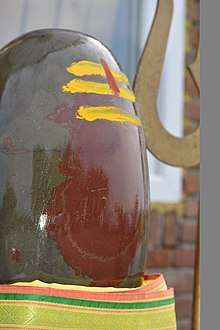Parashiva

Parashiva or Parashiv (Sanskrit: परशिव, IAST: Paraśiva)[1] is one of three aspects of the Hindu God Shiva. According to the Saiva Siddhanta which is a major school of Shaivism ( Shaivism is one of 4 major sampradaya of Hinduism); Parashiva is absolute reality which is beyond human comprehension and is beyond all attributes. In this aspect Lord Shiva is timeless, formless and spaceless.[2][3] In Shaivite theology, Parashiva is both the source and the destination of everything in the universe. The Shaivite concept of Parashiva roughly corresponds with the Vaishnavism concept of "Mahavishnu", the Shaktism concept of Adi Parashakti, and the Smartism concept of "Nirguna Brahman". According to the Saiva Siddhanta other two aspects of Lord Shiva are parashakti and parameshwara.[4][5][6]
The upper part (oval stone) of Shiva lingam represents parashiva while lower part (pedestal) represents parashakti.[7] Parashiva is beyond all the 36 tattva mentioned in shaivism philosophy. [8]
See also
References
- ↑ "Glossary". search for "Paraśiva".
- ↑ Dancing with Siva. pp. ŚLOKA 16 (What Is the Nature of Our God Śiva?).
- ↑ Dancing with Siva. ŚLOKA 17(https://www.himalayanacademy.com/media/books/dancing-with-siva/web/ch02_02.html).
- ↑ "Parashakti".
- ↑ "Parameshwara".
- ↑ Dancing with Siva. Himalayan Accademy. search 'परमेश्वर ' and 'पराशक्ति '. ISBN 0945497946.
- ↑ "Hinduism for Children". Search for "Śivaliṅga".
- ↑ "36 tattva".
